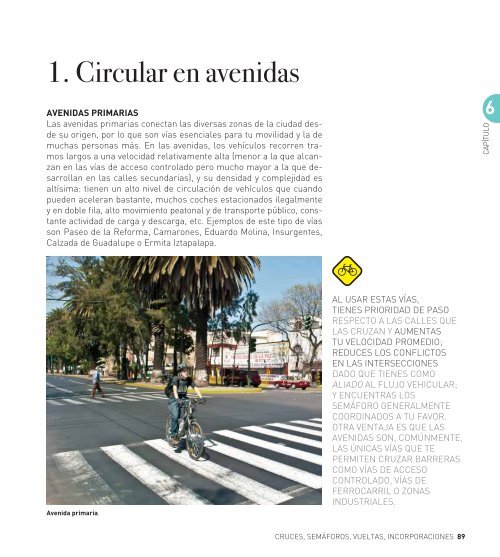You also want an ePaper? Increase the reach of your titles
YUMPU automatically turns print PDFs into web optimized ePapers that Google loves.
1. Circular en avenidas<br />
AVENIDAS PRIMARIAS<br />
Las avenidas primarias conectan las diversas zonas de la ciudad desde<br />
su origen, por lo que son vías esenciales para tu movilidad y la de<br />
muchas personas más. En las avenidas, los vehículos recorren tramos<br />
largos a una velocidad relativamente alta (menor a la que alcanzan<br />
en las vías de acceso controlado pero mucho mayor a la que desarrollan<br />
en las calles secundarias), y su densidad y complejidad es<br />
altísima: tienen un alto nivel de circulación de vehículos que cuando<br />
pueden aceleran bastante, muchos coches estacionados ilegalmente<br />
y en doble fila, alto movimiento peatonal y de transporte público, constante<br />
actividad de carga y descarga, etc. Ejemplos de este tipo de vías<br />
son Paseo de la Reforma, Camarones, Eduardo Molina, Insurgentes,<br />
Calzada de Guadalupe o Ermita Iztapalapa.<br />
Avenida primaria.<br />
AL USAR ESTAS VÍAS,<br />
TIENES PRIORIDAD DE PASO<br />
RESPECTO A LAS CALLES QUE<br />
LAS CRUZAN Y AUMENTAS<br />
TU VELOCIDAD PROMEDIO;<br />
REDUCES LOS CONFLICTOS<br />
EN LAS INTERSECCIONES<br />
DADO QUE TIENES COMO<br />
ALIADO AL FLUJO VEHICULAR;<br />
Y ENCUENTRAS LOS<br />
SEMÁFORO GENERALMENTE<br />
COORDINADOS A TU FAVOR.<br />
OTRA VENTAJA ES QUE LAS<br />
AVENIDAS SON, COMÚNMENTE,<br />
LAS ÚNICAS VÍAS QUE TE<br />
PERMITEN CRUZAR BARRERAS<br />
COMO VÍAS DE ACCESO<br />
CONTROLADO, VÍAS DE<br />
FERROCARRIL O ZONAS<br />
INDUSTRIALES.<br />
CRUCES, SEMÁFOROS, VUELTAS, INCORPORACIONES 89<br />
6<br />
CAPÍTULO


